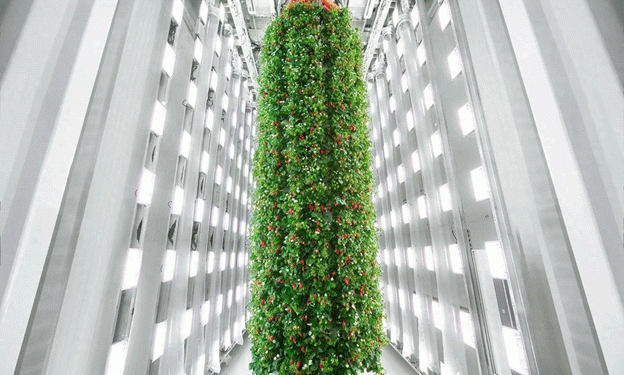Vertical farming has revolutionized crop production, providing a sustainable alternative to traditional farming. The latest breakthrough is the opening of the world’s first large-scale indoor vertical berry farm in Richmond, Virginia. With a focus on strawberries, the farm is poised to produce more than 4 million pounds of berries annually using a fraction of the land and water required by traditional agriculture. This innovation is significant for food production as it tackles both sustainability and scalability in response to global food demand.
A Game-Changer in Berry Farming
Constructed by Plenty, a leader in vertical agriculture, the Richmond farm occupies less than 40,000 square feet—equivalent to just under one acre—but produces on a scale typically requiring far more land. The strawberries grow in nine-meter-tall towers and under controlled conditions across 12 separate growing “rooms,” where temperature, light, and humidity are meticulously regulated. This controlled environment allows the farm to produce strawberries year-round with consistent quality and yield.
By using vertical stacking and hydroponic technology, the Richmond farm uses 97% less land and up to 90% less water than traditional strawberry fields, which depend on seasonal growing conditions. This approach not only conserves resources but also eliminates the need for pesticides, creating safer and more sustainable products. Moreover, the controlled indoor environment reduces crop disease risk, maintaining high-quality produce throughout the year.
Meeting the Growing Demand for Berries
Plenty’s partnership with global berry brand Driscoll’s allows the Richmond farm to produce premium-quality strawberries with the same taste and texture that consumers have come to expect. The farm aims to have these berries available in stores by early 2025, bridging a gap in the berry market by offering locally grown, pesticide-free options year-round. By shortening the supply chain, the farm can deliver fresher berries to local markets, reducing carbon emissions associated with long-distance transportation.
Paul Gauthier, a professor specializing in controlled environment agriculture at the University of Queensland, emphasizes the energy efficiency and scalability of vertical farms. His research shows that strawberry plants grown in these environments can yield up to three times the berries per plant compared to greenhouses. By optimizing light and airflow based on plant growth cycles, vertical farms can use off-peak energy efficiently, making the operation more sustainable and economically viable.
The Future of Vertical Farming and Global Food Security
The Richmond farm marks a significant step in expanding the types of crops that can be produced in vertical farming. Previously, vertical farming was largely limited to leafy greens, but this breakthrough shows that berries—and potentially many other types of fruit—can also be cultivated in controlled environments. This development has implications for global food security, as controlled environment agriculture offers stable yields and resilience against climate change and extreme weather.
Driscoll’s CEO, Soren Bjorn, highlights the strategic importance of this partnership, stating that the combination of Driscoll’s century-long expertise in berry farming with Plenty’s technological prowess can ensure high-quality, flavorful strawberries that are grown locally and sustainably. The success of this venture could pave the way for similar farms around the world, helping meet the UN’s projection that food production must increase by 70% by 2050.
The opening of Plenty’s vertical strawberry farm in Virginia represents a milestone in sustainable agriculture. By producing high-quality berries with minimal land and water use, this innovation showcases the potential of vertical farming to meet rising food demand. As vertical farming technology continues to advance, this model could be replicated worldwide, offering a resilient solution to challenges facing traditional agriculture.










